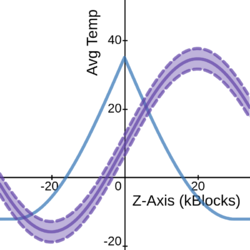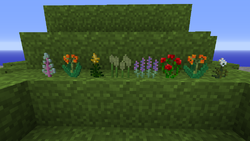Differences From Classic
Jump to navigation
Jump to search
Contents
World Generation and Spawn
- z=0 is now in the temperate zone, and spawn selection is vanilla Minecraft.
- By default, the temperature gets warmer in the positive-z (south) direction for 10k blocks, and then gets colder again, and the reverse for negative-z.
Trees
- Many tree models are updated, and may be different sizes than before (e.g. White Cedar)
Firepits
- To make a firepit, use 3 sticks, at least one log, and optionally 1-5 pieces of tinder (straw, paper, etc.). Tinder will increase the chance of success 10% per piece. To light, use the usual firestarter or flint+steel.
Skills
- Prospecting skill increases only when the propick is clicked on ore blocks at least 192 blocks apart.
- The three smithing skills have been merged into one "Smithing" skill - however there are still different categories internally, so you do have to smith different types of objects to attain full skill.
Nugget Generation
- Surface nuggets are created from ore bodies at y-level 82 (half way through the usual second layer) and above, and within the 3x3 chunks around the chunk where the nugget spawned.
Charcoal Pits
- Log piles without 16 logs will not hold up blocks.
Clay/Pit Kiln/Ceramics
- Indications of clay deposits have been expanded to 8 different plants. TODO: Update image with 3D sprites.
- Place items in pit kilns or in world with "v" by default instead of shift-right-click. "V" will place an item flat like rocks/nuggets.
- Empty ceramic molds and small vessels continue to be hot after the metal is removed, and will cool down at the usual rate.
Forge
- Side slots cannot hold charcoal or ingots.
- Side slots only hold one item each, and only those which can hold liquid and heat (currently only molds and small vessels).
- Tool molds placed in the side slots will be filled if Tier I-II tool metals melt in the forge.
- Small vessels will catch melted liquids from the forge, up to 4000 units.
- Small vessels in each of the four side slots can catch different metals.
- Small vessels can be heated in the forge, and will alloy their contents at Brilliant White temperature.
- Unfired Clay molds placed in the forge will burn up if heated to Brilliant White.
- Metal armor and weapons can be melted in the forge.
- Food can be cooked in the forge.
Smithing
- Welding still needs flux in the anvil GUI. Right-cl
Food
- Sandwiches and Salads are missing.
- Taste system is gone and won't be returning.
- Preservation methods are partially present. Salting, brining, smoking, and drying are not implemented (yet?).
- Food weights are gone. Each piece of food roughly translates to 5oz of food(?). This is an important compatibility change.
- Decay works very differently. Every piece of food has creation and rotted by dates. These can be extended by preservation, and may prevent food from stacking. Combining food in the crafting grid meshes the decay dates, so foods can stack. Not yet balanced
Containers
- Barrels only contain fluids. They are still used for pickling, tanning, etc., but do not have a multiple-slot inventory.
- Gunpowder barrels are still in question.
- Both small and large vessels preserve food. (Other containers?)
- See Forge section for additional uses of small vessels.
- The back slot for barrels, anvils, large vessels, or quivers is gone. More than one anvil, sealed barrel, or vessel in your inventory will result in slowness and fatigue. Even one item will greatly increase your water and food usage. not yet balanced

